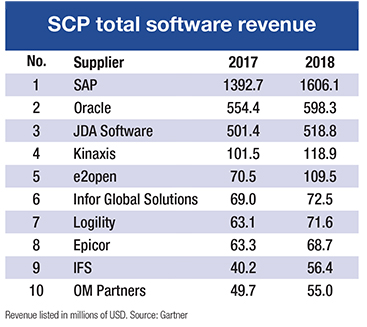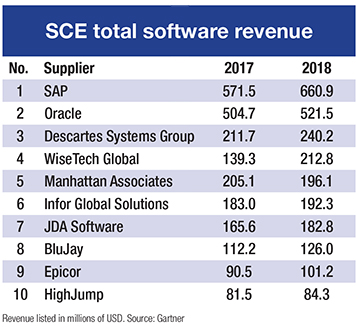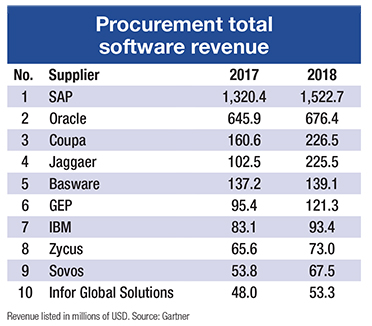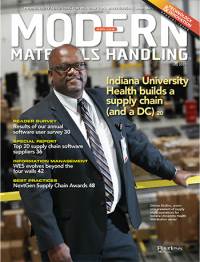2019 Top 20 Supply Chain Software Suppliers
The technology that drives today’s supply chains is getting stronger, better and faster thanks to an innovative group of suppliers pushing the envelope.
Whether they’re getting shipment alerts, managing warehousing inventory, doing demand forecasting, or using analytics to make good decisions, you can bet the warehouse and logistics personnel managing these tasks are using software to get the job done.
Be it a transportation management system (TMS) for connecting to carriers, a warehouse management system (WMS) for orchestrating inventory within the four walls, or a broader enterprise resource planning (ERP) solution that incorporates many functions, the technology that drives the supply chain is getting stronger, better and faster every year.
As supply chain becomes a bigger priority for companies of all sizes, the need for software that supports and streamlines this important business component has also grown. With e-tailers like Amazon pushing the envelope on same- and next-day shipping, e-commerce sales skyrocketing—consumers spent $504.6 billion online last year, a number that’s expected to hit $735 billion by 2023—and many companies still using old or manual-based systems to manage warehousing, fulfillment and distribution, the supply chain management (SCM) sector continues to climb steadily every year.
Made up of supply chain planning (SCP) and supply chain execution (SCE) software, SCM is still led by the world’s largest software developers, although a few smaller, scrappier players are beginning to chip away at those larger players’ market share. According to an annual report from Gartner on the worldwide revenue of the supply chain software market, in 2017 and 2018, the top four suppliers maintained their positions and order, with SAP, Oracle, JDA and Infor claiming those spots on Gartner’s list.
Descartes Systems Group moved up a notch to fifth, with Coupa on its heels in sixth (up from seventh last year). This year’s fastest-climber was Jaggaer, which enters the Top 20 chart at No. 7, followed by Manhattan Associates (which dropped three spots from 2017), WiseTech Global (up one notch), and Epicor, which descended by two places over 2017.
In pursuit of growth
Balaji Abbabatulla, Gartner UK’s senior director of product management research for SCM software, says Jaggaer’s leapfrogging can be traced to the spend management solution provider’s 2017 acquisition of BravoSolution, a maker of global strategic procurement platforms and No. 18 on last year’s list. The combined company now has 1,850 customers connected to a network of 4 million suppliers in 70 countries, according to Jaggaer.
According to the Top 20, the SCM growth leaders are E2open (with 54% growth from 2017 to 2018), WiseTech Global (53%), IFS (42%), Coupa (41%) and Apttus (40%). Rounding out the growth leaders list were Tradeshift (28%), GEP (27%), Sovos (26%), Ivalua (25%) and Jaggaer (24%).
“When Jaggaer bought BravoSolution it grew in terms of revenue and got into the top 10 SCM ranking,” says Abbabatulla. “Outside of that, there weren’t any real significant shifts between 2017 and 2018.” He’s keeping an eye on Coupa, a business spend management (BSM) provider that’s on a spending spree of its own, having just acquired contract lifecycle management provider Exari In May. “Coupa continues to grow faster than most other vendors in the top 10 right now,” says Abbabatulla, “and probably has the highest growth rate of the group.”
Top 20 supply chain management software suppliers
SCM (SCE, SCP, Procurement) Total Software Revenue
|
No. |
Supplier |
2017 |
2018 |
|
1 |
SAP |
3,284.6 |
3,789.7 |
|
2 |
1,651.9 |
1,716.7 |
|
|
3 |
720.0 |
781.1 |
|
|
4 |
299.9 |
318.1 |
|
|
5 |
211.7 |
240.2 |
|
|
6 |
160.6 |
226.5 |
|
|
7 |
182.2 |
225.5 |
|
|
8 |
224.9 |
215.5 |
|
|
9 |
139.3 |
212.8 |
|
|
10 |
156.3 |
175.0 |
|
|
11 |
109.6 |
168.5 |
|
|
12 |
137.2 |
139.1 |
|
|
13 |
112.2 |
126.0 |
|
|
14 |
95.4 |
121.3 |
|
|
15 |
117.9 |
119.6 |
|
|
16 |
101.5 |
118.9 |
|
|
17 |
67.9 |
96.3 |
|
|
18 |
81.5 |
84.3 |
|
|
19 |
68.9 |
74.8 |
|
|
20 |
67.5 |
74.7 |
|
|
Top 20 total |
7991 |
9024.6 |
|
|
Other vendors |
4575.9 |
5,107.9 |
|
|
Total |
12,566.9 |
14,132.5 |
|
By the numbers
In terms of total software revenue for SCE, SCP and procurement, SAP ranks at the top of the list with $3.79 billion in revenue—up from $3.28 billion in 2017. Breaking that number down further, the software maker sold $661 million in SCE, $1.6 billion in SCP, and $1.52 billion in procurement software.
Oracle’s SCM revenues rose from $1.65 billion in 2017 to $1.72 billion in 2018, with total SCE software revenue of $521 million, SCP at $598 million, and procurement at $676 million. Next on the list is JDA, which saw its annual total SCM software revenues rise from $720 million to $781 million. Infor sold $318 million in SCM software, with Descartes, Coupa, Jaggaer, Manhattan Associates, and WiseTech Global all falling into the $212 million to $240 million annual revenue range.
Cumulatively, SCM software providers sold $4.38 billion in SCE (up from $3.98 billion in 2017), $4.95 billion in SCP (versus $4.45 billion), and $4.80 billion in procurement (up from $4.13 billion) software in 2018.


Using Cloud to deliver value
According to Abbabatulla, the push to adopt Cloud-based SCM solutions continues to drive growth in the SCM sector, where he says the “Cloud native” vendors are dominating the market.
“Pretty much all of the top growth leaders are Cloud-native vendors, so there is no surprise that Cloud continues to dominate,” says Abbabatulla, who notes that Cloud alone doesn’t guarantee a vendor’s growth. “It’s about how these vendors are using the Cloud to deliver value, and how they’re going about doing that.”
He points to E2open and WiseTech Global as the two high-fliers in the Cloud-based SCM category for 2018—a trend that will likely continue this year. The common thread across the two, he says, is the ability to seamlessly expand the set of features they offer customers. Having a single, unified experience through which vendors deliver a number of features that customers can easily add onto their existing systems, for example, is very alluring to companies operating in the fast-moving distribution environment.
“When companies can easily add on without going through a whole implementation-deployment-integration process, and all while using the same set of features they’re already using, it’s a pretty compelling argument,” Abbabatulla points out, noting that this approach is not limited to Cloud-native vendors. For example, he says IFS is a good example of an on-premise software provider that’s added Cloud to its delivery options, but that’s still largely focused on its traditional delivery method.
“All of IFS’ core customer segments are traditional engineering, aeronautics and manufacturing industries that are heavily [invested in] on-premise solutions,” Abbabatulla explains. And while IFS’ growth has largely focused on developing targeted solutions for its core industry segments, the company is now taking a multi-pronged approach to its business: deliver better value to on-premise customers while also adding Cloud options to its lineup. “The Cloud isn’t a major growth factor for IFS,” he adds, “but it does help the company make it easy for customers to use more features with minimal additional effort.”
Investing in the future
Looking at this year’s Top 20 numbers, Abbabatulla says the overall SCM market grew by about 12.5% between 2017 and 2018. Of the three segments that SCM covers, procurement saw an uptick of 16.3%, followed by SCP at 10.9% and SCE at 10.1%. “Procurement pulled the growth rate up overall,” he says. At least some of that uptick can be traced to the ongoing push for digitizing the procurement process, and the fact that buyers have long relied on manual processes to run their departments.
“Not a lot of procurement processes were digitized to begin with, so many procurement departments started off with a clean slate,” Abbabatulla points out. “As a result, they didn’t have the challenge of replacing legacy solutions. They just went right into it saying, ‘OK, we have a bunch of manual processes. We need to digitize them, so who has the best solution?’”
Procurement software is also getting a boost from the addition of direct spend management to its menu of options. Traditionally dedicated to managing indirect spend, these programs have broadened out to where they now help companies orchestrate more strategic sourcing activities.
“If indirect sourcing led to the current market size—which incidentally, outgrew SCE in 2018 and will grow faster than SCP in the next few years,” Abbabatulla predicts, “then we’re going to see even more growth ahead as more companies use software for direct sourcing.”
 Abbabatulla also sees potential ahead for SCM developers, and SCE in particular. “SCE is in a really interesting place right now,” he says. “Clearly, there are still a lot of SCE legacy applications in use, with companies continuing to use on-premise software that’s been in place for 25 or 30 years.”
Abbabatulla also sees potential ahead for SCM developers, and SCE in particular. “SCE is in a really interesting place right now,” he says. “Clearly, there are still a lot of SCE legacy applications in use, with companies continuing to use on-premise software that’s been in place for 25 or 30 years.”
That landscape is beginning to shift as companies invest in more robotics, automation and IoT-enabled equipment, all of which requires the support of more modern, state-of-the-art software systems than those made in the 1980s and 1990s.“As IoT becomes more prevalent, and with the increasing use of robots,” Abbabatulla says, “we could see a higher emphasis placed on good decision making in a sector where the focus has been more on cost reduction, and less on investing in developing new systems for the future.”
Making the list
This is the 18th time Modern has reported on the supply chain software market from a business standpoint. Although we initially focused on the top providers of WMS solutions, the lines between supply chain execution and supply chain planning providers are no longer clearly drawn; enterprise resource planning (ERP) providers supply WMS and supply chain execution providers offer planning and optimization solutions. Companies are increasingly looking to integrate their procurement activities into their manufacturing, distribution and transportation strategies.
For that reason, Modern partners with Gartner to create this list. Our starting point is Gartner’s annual list of the top supply chain management providers. It’s a numbers game and not a popularity contest. The rankings are based on Gartner’s estimates of a provider’s annual sales for 2018. Meanwhile, Gartner’s estimates are based on revenues related to supply chain management software and not a company’s total revenues.
Admittedly, this is an imperfect science. Gartner, for instance, strips out hardware sales from its estimates. What’s more, Gartner does not follow the warehouse control systems (WCS) or manufacturing execution system (MES) spaces for the purposes of its chart.
Finally, it does not include SCM suppliers that focus on specific verticals. That said, it is an apples to apples comparison to previous years.

Article Topics
Software News & Resources
C-suite Interview with Keith Moore, CEO, AutoScheduler.AI: MODEX was a meeting place for innovation C-Suite Interview with Frank Jewell of Datex, Leading the Way in the Material Handling Industry Give your warehouse management systems (WMS) a boost Agility Robotics and Manhattan Associates partner to bring AI-powered humanoid robots into warehouses Siemens, Universal Robots, and Zivid partner to unveil smart robotic picking solution OTTO Motors showcases latest software release for optimizing floor space Rite-Hite ONE digital platform debuts More SoftwareLatest in Materials Handling
Registration open for Pack Expo International 2024 Walmart chooses Swisslog AS/RS and software for third milk processing facility NetLogistik partners with Vuzix subsidiary Moviynt to offer mobility solutions for warehouses Materials Handling Robotics: The new world of heterogeneous robotic integration BSLBATT is looking for new distributors and resellers worldwide Lucas Watson appointed CSO for Körber’s Parcel Logistics business in North America Hyster recognizes Dealers of Distinction for 2023 More Materials HandlingAbout the Author
Subscribe to Materials Handling Magazine

Find out what the world's most innovative companies are doing to improve productivity in their plants and distribution centers.
Start your FREE subscription today.
April 2024 Modern Materials Handling

Latest Resources












